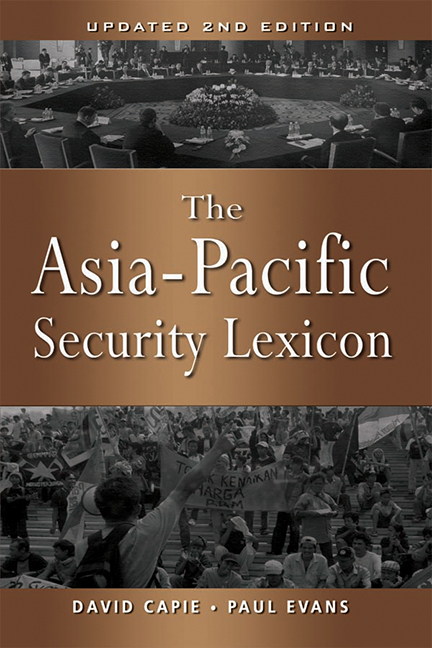Book contents
- Frontmatter
- Contents
- Abbreviations
- Introduction to the Second Edition
- Ad Hoc Multilateralism
- A la Carte Multilateralism
- The “ASEAN Way”
- Balance of Power
- Bilateralism
- Coalition of the Willing
- Coercive Diplomacy
- Collective Defence
- Collective Security
- Common Security
- Comprehensive Security
- Concert of Powers
- Concerted Unilateralism
- Confidence-Building Measures
- Confidence- and Security-Building Measures
- Constructive Intervention
- Cooperative Security
- Engagement
- Flexible Consensus
- Human Security
- Humanitarian Intervention
- Middle Power
- Multilateralism
- Mutual Security
- New Security Approach
- Non-Traditional Security
- Open Regionalism
- Peaceful Rise
- Pre-emption and Preventive War
- Preventive Diplomacy
- Security Community
- Terrorism
- Track One
- Track One-and-a-Half
- Track Two
- Track Three
- Transparency
- Trust-Building Measures
- About the Authors
Confidence- and Security-Building Measures
Published online by Cambridge University Press: 21 October 2015
- Frontmatter
- Contents
- Abbreviations
- Introduction to the Second Edition
- Ad Hoc Multilateralism
- A la Carte Multilateralism
- The “ASEAN Way”
- Balance of Power
- Bilateralism
- Coalition of the Willing
- Coercive Diplomacy
- Collective Defence
- Collective Security
- Common Security
- Comprehensive Security
- Concert of Powers
- Concerted Unilateralism
- Confidence-Building Measures
- Confidence- and Security-Building Measures
- Constructive Intervention
- Cooperative Security
- Engagement
- Flexible Consensus
- Human Security
- Humanitarian Intervention
- Middle Power
- Multilateralism
- Mutual Security
- New Security Approach
- Non-Traditional Security
- Open Regionalism
- Peaceful Rise
- Pre-emption and Preventive War
- Preventive Diplomacy
- Security Community
- Terrorism
- Track One
- Track One-and-a-Half
- Track Two
- Track Three
- Transparency
- Trust-Building Measures
- About the Authors
Summary
While there is widespread agreement that the aim of confidence and security-building measures (CSBMs) is to reduce uncertainty, misperception, and suspicion, and thus help lessen the possibility of armed conflict, there is no commonly accepted definition of what constitutes a confidence- and security-building measure. To add to the confusion, the term is also often used interchangeably with confidence-building measures (CBMs) and other similar expressions. For example, a Council for Security Cooperation in the Asia Pacific (CSCAP) report on the subject said that CSBMs encompass and embrace “the spirit and intent of proposals calling for trust-building measures, mutual assurance measures, mutual reassurance measures, community-building measures, and other related confidence-building concepts”.
Like confidence-building measures, the origins of the term confidence- and security-building measures lie in Cold War Europe. Confidence-building measures was first used during the negotiations which culminated in the publication of the Helsinki Final Act (1975). In 1983, the Conference on Security and Cooperation in Europe (CSCE) states met in Madrid as a followup to the Helsinki Process to discuss convening a Conference on Disarmament in Europe (CDE). The Madrid meeting's “Concluding Document” first used the term confidence- and security- building measures. According to Victor-Yves Ghebali, the genesis of the term lies in a Yugoslav proposal put forward during informal discussions on military issues. The proposal suggested that “security-building measures” could be added (as a separate concept) alongside “confidence-building measures.” However, this dichotomy was unacceptable to the West, and it was finally decided to use the consolidated term confidence- and security-building measures to describe the new measures set out in the Madrid Process. These measures were intended to extend the CBMs agreed upon as part of the Helsinki Process. CSBMs, in contrast with Helsinki's CBMs, were not independent of each other but were supposed to be a series of mutually complementary measures.
According to Ralph Cossa, definitions of CSBMs vary, “ranging from the very narrow (looking almost exclusively at military measures) to much broader interpretations encompassing almost anything that builds confidence”.
- Type
- Chapter
- Information
- The Asia-Pacific Security Lexicon (Upated 2nd Edition) , pp. 93 - 96Publisher: ISEAS–Yusof Ishak InstitutePrint publication year: 2007



